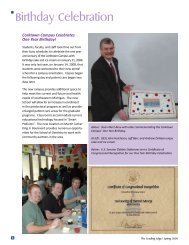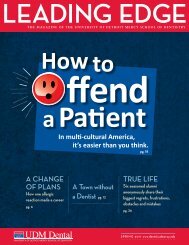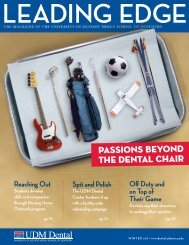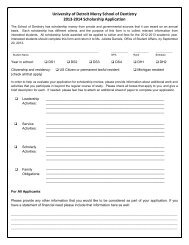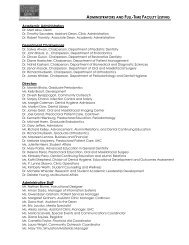From the DeanDear <strong>School</strong> <strong>of</strong> <strong>Dentistry</strong> Alumni and Friends,As I mark the first anniversary <strong>of</strong> my appointment as Dean, I would like to take thisopportunity to share the significant accomplishments achieved over the past few months. Inspite <strong>of</strong> the many challenges facing the State <strong>of</strong> Michigan and especially our local economy,I am proud to say that not only has the dental school managed to grow our student body butwe are also stepping up to the challenge <strong>of</strong> expanding our community outreach programs. Toreiterate, we are not shrinking and cutting programs because <strong>of</strong> these tough times, but we areactually expanding our outreach programs, continuing investment in educational technologyand faculty recruitment because this is needed now more than ever.Below is a sampling <strong>of</strong> our community outreach accomplishments <strong>of</strong> the past few monthsalong with our plans for the future:▪ On Saturday, February 7 th , the <strong>Detroit</strong>, Macomb and Oakland District Dental Societieshosted their fifth annual Give Kids A Smile Day at the <strong>School</strong> <strong>of</strong> <strong>Dentistry</strong>. Approximately400 volunteers participated, an increase over last year, and 259 children received dental care.▪ In March <strong>of</strong> <strong>2009</strong>, the <strong>School</strong> purchased the latest model Cone-Beam Computed Tomography machine, launching the newlyformed <strong>UDM</strong> Oral and Maxill<strong>of</strong>acial Imaging Center. With the expertise <strong>of</strong> two Board Certified Oral and Maxill<strong>of</strong>acialRadiologists, the <strong>School</strong> <strong>of</strong> <strong>Dentistry</strong> <strong>of</strong>fers imaging and interpretation services for cone-beam scans from around the United States.▪ In May, the <strong>School</strong> hosted the first Michigan Day <strong>of</strong> Oral Health Outreach (MI Door). Over 320 volunteers treated 413uninsured adults providing care valued at over $241,000. See page 14 for pictures and details.▪ This year we completed a full replacement <strong>of</strong> all dental units at our nationally recognized, hospital based clinic at the <strong>Detroit</strong>Medical Center. All 42 dental units were replaced with the latest model dental chairs and delivery systems.▪ Our Dental Clinic had a record year ending June 30 th . We served the highest number <strong>of</strong> patients in our history, and we wereable to increase clinical production over 10%.▪ In the July <strong>2009</strong>, Hour <strong>Detroit</strong> Magazine, 276 dental faculty and alumni from the <strong>School</strong> <strong>of</strong> <strong>Dentistry</strong> were selected by peers to berecognized as being chosen as the Best <strong>of</strong> <strong>Detroit</strong>.▪ We have 10 more scheduled outreach events in the next 4 months providing screenings and basic dental care to thousands<strong>of</strong> children in need.During this first year, the impact we have been able to make on our surrounding communities has been invaluable. Along withthe fact our students are able to work with a diverse pool <strong>of</strong> patients which provides them experiences that they would not be ableto replicate anywhere else, the <strong>School</strong> <strong>of</strong> <strong>Dentistry</strong> continues to be the leader in developing oral health and clinical educationprograms intended on assuring that your alma mater will be doing great things for years to come.These recent past accomplishments and upcoming community outreach programs are a true testament to the energy, enthusiasmand commitment <strong>of</strong> the faculty, staff and students <strong>of</strong> <strong>UDM</strong>. The benefactors <strong>of</strong> this commitment are the patients we serve, thestudents we educate, and the people <strong>of</strong> the State <strong>of</strong> Michigan. You as alumni also benefit by increasing the presence <strong>of</strong> the <strong>UDM</strong>name and the association <strong>of</strong> <strong>UDM</strong> as a leader in oral health.I encourage you to consider supporting us in what we are doing, whether it is volunteering your time, or by making a contributionto our annual fund, so that we can continue to take the lead in solving the problems facing the pr<strong>of</strong>ession and the oral health careneeds <strong>of</strong> the public. Together, we look forward to making a positive difference in the years ahead.Sincerely,Mert N. Aksu, DDS, JD, MHSADean The Leading Edge | Summer <strong>2009</strong>
Dental HygieneIncorporating “Real-Life” Patient Care in the ClassroomOne <strong>of</strong> the goals the Dental Hygiene Program has been working on this academic year is theincorporation <strong>of</strong> meaningful classroom learning activities that focus on developing students’clinical reasoning skills. The pre clinical and prevention courses, led by co-directors DurindaMattana and Laura Manning-Lee, were the first in the curriculum to be restructured tointegrate biomedical, oral medicine, and clinical course content in order for students to moreeffectively analyze patient assessment data and develop evidence-based, individualized dentalhygiene care interventions in the clinical setting. The intent was to utilize multiple learningapproaches to simulate real-life patient care situations applying biomedical concepts.The newly restructured curriculum includes two separate pre clinical courses in the firstand second semesters <strong>of</strong> the program whereby periodontal instrumentation is emphasizedin one course while oral health assessment is the focus <strong>of</strong> the other course. Course contentis introduced in the manner that a typical patient care appointment is conducted. Thus,obtaining patient consent is the initial concept introduced with medical history and vital signscontent following. As each segment is introduced, the introductory biomedical/oral medicine foundation is provided by respectivedepartmental faculty with the hope <strong>of</strong> students being able to gain a better experience for applying the relationship <strong>of</strong> biomedicaland clinical sciences. The use <strong>of</strong> each corresponding electronic patient record form for gathering necessary patient assessment datais also accessed via the student’s personal tablet PC in the classroom as a weekly exercise.Content introduced in each course is coordinated on a weekly basis. For example, periodontal pathogenesis is presented byperiodontal faculty the same week the probe is introduced and practiced in the preclinical course. Again, the goal is for enhancedacquisition <strong>of</strong> knowledge for the biomedical foundation <strong>of</strong> periodontics in a clinical education course. Concepts such as those inoral microbiology and immunology are also introduced at the same time in the biomedical curriculum.The prevention course is delivered in a similar fashion being comprised <strong>of</strong> primary, secondary and tertiary preventive therapiesintroduced in an integrated format by a variety <strong>of</strong> interdisciplinary faculty. All courses described utilize patient cases obtained fromtraditional and/or electronic textbooks or axiUm patient cases for each module presented. Other teaching strategies utilized includein-class group problem-solving activities, hands-on sessions, technological resources such as voice activated online power pointpresentations and novel assignments involving analysis <strong>of</strong> oral products and patient education scripts. The prevention course alsointegrates a variety <strong>of</strong> patient education tools such those found on the www.dentalcare.com website as well as the patient educationsystem CAESY, in order for students to practice patient education techniques throughout the course.It is our hope that the integrated curriculum format will provide a means to incorporate “real- life” patient care in the classroom.The goal is to provide experiences to enhance effective clinical judgment and care. Outcomes thus far reveal that dental hygienestudents are able to apply classroom information to patient care better. Other observations include improved patient communicationskills and evidence-based clinical decision making.Kathi R. Shepherd, RDH, MSDirector, Eduational Development & Outcomes AssessmentDirector <strong>of</strong> Dental Hygiene Program<strong>University</strong> <strong>of</strong> <strong>Detroit</strong> Mercy | <strong>School</strong> <strong>of</strong> <strong>Dentistry</strong>
- Page 2 and 3: Contact UsSchool of Dentistry Conta
- Page 6 and 7: Of NoteDr. Richard Monahan, Head of
- Page 8 and 9: Of NoteKathleen Neveu, RDH, MS, was
- Page 10 and 11: RetirementsDrs. John and Gail Molin
- Page 12 and 13: ADEAUDM a Big Presence at ADEA Annu
- Page 14 and 15: IADR 2009Warren Wagner, MSE, PhDThe
- Page 16 and 17: MI DOORMichigan Day of Oral Health
- Page 18 and 19: MI DOORprovided care for the event.
- Page 20 and 21: Orthodontic Outreach60 Great Smiles
- Page 22 and 23: Special GraduationDental Hygiene St
- Page 24 and 25: Alumni Day 2009Durinda Mattana, RDH
- Page 26 and 27: students through the years. It appe
- Page 28 and 29: Comments from Dr. Mark Frenchi inRe
- Page 30 and 31: Class ReunionsAt left: Dental Class
- Page 32 and 33: 2009 GalaKimberly Mercier-PerryDire
- Page 34 and 35: At left: Rozann and Dr. Charles (
- Page 37 and 38: The UDM School of Dentistry Class o
- Page 39 and 40: Sigma Phi AlphaSigma Phi Alpha is t
- Page 41 and 42: Recipients of the 2009 School of De
- Page 43 and 44: Families CelebrateAbove left: Carol
- Page 45 and 46: *Misty Leighann Conigliaro, RDHEric
- Page 47 and 48: University of Detroit Mercy | Schoo
- Page 49 and 50: University of Detroit MercySchool o
- Page 51 and 52: Nawar Atheer Karmo, BSLaura Jean Ke
- Page 53 and 54: Brian Corey Slighly, BS▪ Quintess
- Page 55 and 56:
At left: Chad Beers and his father,
- Page 57 and 58:
University of Detroit Mercy | Schoo
- Page 59 and 60:
Attention PhotographersPhoto taken
- Page 61 and 62:
Talent Comes Out for “Dental Scho
- Page 63 and 64:
Top: Dr. John Molinari (center) wit
- Page 65 and 66:
Vistas Nuevas Head StartPamela Gibe
- Page 67 and 68:
Students Pursuing Postgraduate Stud
- Page 69 and 70:
Dr. Robert NiskarThe Oral Cancer Wa
- Page 71 and 72:
1990’sDanielle Binder Ruskin, DDS
- Page 73 and 74:
November 2009January 2010Occupation
- Page 75 and 76:
Dental Alumni Board2009-10President




